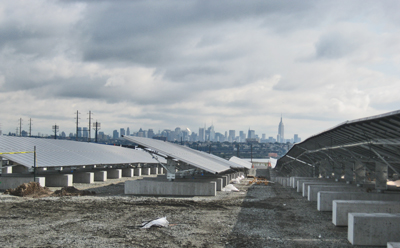
A 3-MW New Jersey landfill Project from Solar FlexRack.
Landfills
Two of the most common types of landfill construction and classification are sanitary (municipal waste) and construction, demolition and debris (CDD) landfills. Sanitary landfills are normally constructed under rigid environmental specifications and standards, including rubber membrane linings for leachate collection, ground water monitoring wells, methane gas monitoring wells and often a PVC piping grid for venting. CDD landfills usually contain inert building materials such as concrete, brick and rock spoils and, therefore, are not regulated by stringent environmental requirements. They are typically closed with a simple soil cap.
When possible, landfills are typically sited and constructed in naturally occurring or artificially created topographic low landform features. However, in some cases, if shallow ground water levels exist or shallow bedrock is present, the landfills are constructed entirely above grade in convex mounds. In the early 20th century, common practice was to fill abandoned quarries or strip mines with refuse, which, upon closure, usually left a relatively level ground surface. Many landfill sites located in municipalities that are decommissioned and in post-closure monitoring are prime candidates for adaptive reuse for commercial utility-scale solar energy plants.
Construction challenges associated with landfill reuse include:
■ The rubber membrane liner/cap in sanitary landfills;
■ The highly variable debris content within the CDD landfills;
■ Limited accessibility within the landfill footprint to vehicular traffic; and
■ Finish grades and/or orientation of the landfill itself.
If landfills are constructed in a north-south orientation with excessively steep finish grades east to west (greater than 20 percent) across the landfill site, construction of solar arrays may be difficult without employing high-angle tilt racking components. For the sanitary landfill, installation of direct driven pilings, earth screws and helical piles is often precluded by the rubber membrane cap, and in the CDD landfill, there is a high likelihood of encountering building debris that will lead to multiple pile refusals. A concrete ballast foundation is one of the most common foundation solutions for landfill construction.
Next up, Brownfields (click next page)
— Solar Builder magazine

Leave a Reply
You must be logged in to post a comment.